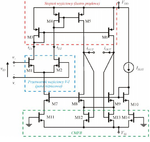Alpacca
Newbie level 6
I'm working on simple OTA. I know the purpose of CMFB, I just don't know how exactly in this particular case it works:

Common mode voltage increases (from iout), resistance of transistors M12 and M13 decreases and so does source voltage of M8 and M9, but how it influences common mode voltage? And why there are transistors M11 and M14?

Common mode voltage increases (from iout), resistance of transistors M12 and M13 decreases and so does source voltage of M8 and M9, but how it influences common mode voltage? And why there are transistors M11 and M14?